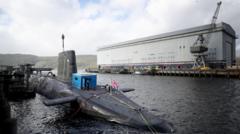Did Radioactive Water Leak into the Loch from a Nuclear Base?

Understanding the Fallout: Radioactive Water Leak from a Royal Navy Nuclear Base
The recent revelation of radioactive water leakage from the Royal Navy's Coulport armaments depot into Loch Long has garnered significant attention. This incident, linked to the failure of old pipes, sheds light on broader issues related to nuclear safety, environmental concerns, and governmental transparency. Official documents, released after a protracted battle for access, indicate that maintenance shortfalls have led to potential risks, although regulatory bodies assert that these do not pose a significant environmental threat. This article delves into the implications of this situation, exploring the context, the findings, and what they mean for the future of nuclear safety in Scotland.
The Background of Coulport Armaments Depot
Located in Argyll and Bute, the Coulport armaments depot plays a crucial role in the UK's nuclear defense strategy. It serves as the storage facility for the Royal Navy's Trident submarine fleet's nuclear warheads. Given its strategic importance, the management and safety of this site are paramount. However, the recent findings related to pipe maintenance raise questions about the effectiveness of the current oversight and maintenance protocols in place.
Details of the Leak
The investigation, led by The Guardian and The Ferret, revealed that the leak of radioactive water was linked to a series of pipe bursts, with incidents dating back to as early as 2010. The most concerning occurrence happened in August 2019, where low levels of tritium, a radioactive isotope used in nuclear weaponry, were released into the loch. While the Scottish Environment Protection Agency (SEPA) stated that these discharges posed "no regulatory concern," the presence of radioactive materials in any capacity raises alarm bells for environmental activists and local communities alike.
Regulatory Oversight and Environmental Safety
The SEPA is responsible for monitoring environmental compliance and pollution control in Scotland. Their assessments regarding the Coulport facility highlighted that the root cause of the leaks was inadequate maintenance of the water pipe network, which comprises around 1,500 pipes. Despite assurances from the Ministry of Defence (MoD) that there have been "no unsafe releases" of radioactive materials, the documentation uncovered paints a picture of systemic maintenance issues that need addressing.
The Role of Transparency and Public Interest
The release of these official documents came only after a ruling by Scottish Information Commissioner David Hamilton, who determined that the public had a right to access this information. His decision was influenced by the need for transparency over national security concerns, suggesting that the government may have prioritized reputational protection over public safety. The balance between safeguarding sensitive information and ensuring public awareness is a delicate one, particularly in matters involving nuclear safety.
Environmental and Public Health Implications
While SEPA maintains that the risk from radioactive discharges is minimal, this situation raises several important questions regarding long-term environmental impacts. The potential for cumulative effects of low-level radioactive discharges on local ecosystems and human health cannot be overlooked. Public confidence in the management of such sites must be restored, which can be achieved through rigorous monitoring, transparent reporting, and community engagement.
Next Steps: Addressing Maintenance and Safety Concerns
In response to the findings, the Ministry of Defence has acknowledged the importance of maintaining high safety standards regarding radioactive substances. They have indicated that an extensive replacement program for outdated components has already been initiated. This proactive approach is critical in preventing future incidents and ensuring the safety of both the environment and the public. Regular audits and assessments will be essential in maintaining oversight and accountability.
The Bigger Picture: Nuclear Safety in the UK
This incident serves as a reminder of the complexities surrounding nuclear safety and the management of such facilities. The UK has a long history of nuclear power and weaponry, which brings with it both benefits and risks. Ensuring that stringent safety measures are in place is paramount, not only for protecting the environment but also for maintaining public trust in governmental institutions.
Frequently Asked Questions
What caused the radioactive water leak at Coulport?
The leak was attributed to a series of pipe bursts that occurred due to inadequate maintenance of the facility's water pipe network. These issues date back several years, with a notable incident occurring in August 2019.
Is the radioactive material in Loch Long harmful?
According to the Scottish Environment Protection Agency, the levels of radioactive material released into Loch Long are considered to pose "no regulatory concern." However, the long-term effects of any radioactive contamination on both the environment and public health are still a matter of concern for community members and environmental advocates.
What measures are being taken to prevent future leaks?
The Ministry of Defence has initiated an extensive replacement program for the outdated components of the water pipe network at Coulport. Ongoing assessments and monitoring are critical to ensuring the facility operates in accordance with high safety standards.
How does this incident affect public trust in government institutions?
The release of these documents and the subsequent findings highlight the need for transparency and accountability in the handling of nuclear materials. Public trust can be regained through open communication, rigorous monitoring, and community engagement regarding environmental safety.
The incident at Coulport raises serious questions about nuclear safety and regulatory compliance in the UK. As the government undertakes measures to address maintenance issues, it is crucial for both the authorities and the public to remain vigilant. How can we ensure that safety standards are upheld in the future? #NuclearSafety #EnvironmentalProtection #PublicTrust
Published: 2025-08-09 16:42:38 | Category: technology



